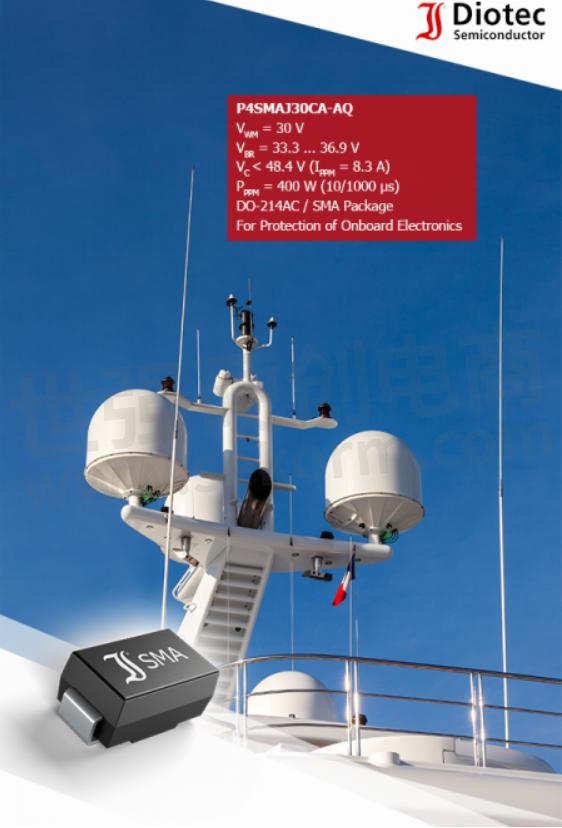Diotec‘s P4SMAJ30CA-AQ TVS Offers 30V of Working Voltage and 400W of Peak Pulse Power for Sensitive Onboard Electronics

A long time ago, a ship offshore was totally disconnected from the rest of the world. Short distances could be spanned by optical signals like flags, mirrored sunlight or flare, but required clear view. The world's first radio transmission at all (and from an island!) was done by Guglielmo Marconi 1897, using a spark-gap transmitter. The principle of that set-up was detected just few years ago, 1887 by Heinrich Hertz: An electric spark creates radio waves which spread into the air.

The still used German term "Funkübertragung" for radio transmission stems from that spark-gap effect. In 1901, Marconi managed already to send a message across the Atlantic ocean - this was the start for successful marine communications. Even small boats use nowadays maritime radio systems, supplied by the onboard 12 or 24 V battery system. Like in a car supply, the disconnection of the battery (also called load dump) can cause voltage spikes exceeding easily 100 V. At sea there is further the risk of lightning strikes hitting the radio antenna.
Transient Voltage Suppressor diodes (TVS) are therefore used to protect the sensitive onboard electronics. The P4SMAJ30CA-AQ is a typical TVS used in the second level of protection, that means at the interfaces of an electronic circuit, in addition to centralized load dump protectors and lightning arresters. It offers 30V of working voltage, well above the 28 Volt of a fully charged 24V battery, and 400W of peak pulse power at the typical lightning pulse 10/1000µs.
- +1 Like
- Add to Favorites
Recommend
- Space Saving Snubber Solution for Auxiliary Supplies in White Goods: US1J+P6SMA240A
- Diotec Offers Several Semiconductor Solutions Dedicated for Smart Meter Needs
- Diotec‘s Product Portfolio Offer Discrete Solutions for EV Charging
- Diotec Linear Voltage Regulators - Stable Output Voltage at Low Costs
- Diotec Ultrafast Rectifier US1M——Why It Makes Sense to Use a 1000 V Component on a 24 V Smart Building Field Bus System?
- Diotec Bipolar Transistor BC847BP in the DFN1006-3 Package, Suitable for Many Kinds of Electronic Control Purposes in Toy Robots
- What Diotec Bipolar Transistor MMDT2227 Has to Do with Cheerful Coloured Eggs?
- Why Should We Choose Unidirectional TVS as Much as Possible When Selecting TVS
This document is provided by Sekorm Platform for VIP exclusive service. The copyright is owned by Sekorm. Without authorization, any medias, websites or individual are not allowed to reprint. When authorizing the reprint, the link of www.sekorm.com must be indicated.





























































































































































































































































































































































































































































































































































































































































































































































































































































































